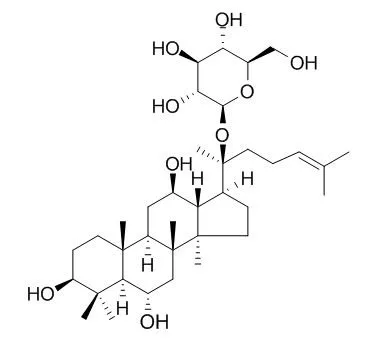| In vitro: |
| Exp Dermatol. 2014 Nov;23(11):860-2. | | Role of epidermal γδ T-cell-derived interleukin 13 in the skin-whitening effect of Ginsenoside F1.[Pubmed: 25091975] | Ginsenoside F1 (GF1) is a metabolite of ginsenoside Rg1. Although Ginsenoside F1 has several benefits for skin physiology, the effect of Ginsenoside F1 on skin pigmentation has not been reported.
METHODS AND RESULTS:
We found that a cream containing 0.1% Ginsenoside F1 showed a significant whitening effect on artificially tanned human skin after 8 weeks of application. However, Ginsenoside F1 did not inhibit mRNA expression of tyrosinase or dopachrome tautomerase (DCT) in normal human epidermal melanocytes (NHEMs) or cocultured NHEMs/normal human epidermal keratinocytes. Interestingly, Ginsenoside F1 enhanced production of interleukin 13 (IL-13) from human epidermal γδ T cells. IL-13 significantly reduced the mRNA expression and protein amount of both tyrosinase and DCT and reduced melanin synthesis activities in NHEMs, resulting in visible brightening of NHEM pellet.
CONCLUSIONS:
These results suggest that enhancement of IL-13 production by Ginsenoside F1 from epidermal γδ T cells might play a role in the skin-whitening effect of GF1 via the suppression of tyrosinase and DCT. | | J. Ginseng Res., 2011, 35(1):86-91. | | Ginsenoside F1 Modulates Cellular Responses of Skin Melanoma Cells.[Reference: WebLink] | Ginsenoside F1 (G-F1) is an enzymatic metabolite generated from G-Rg1. Although this metabolite has been reported to suppress platelet aggregation and to reduce gap junction-mediated intercellular communication, the modulatory activity of G-F1 on the functional role of skin-derived cells has not yet been elucidated.
METHODS AND RESULTS:
In this study, we evaluated the regulatory role of G-F1 on the cellular responses of B16 melanoma cells. G-F1 strongly suppressed the proliferation of B16 cells up to 60% at 200 ug/mL, while only diminishing the viability of HEK293 cells up to 30%. Furthermore, G-F1 remarkably induced morphological change and clustering of B16 melanoma cells. The melanin production of B16 cells was also significantly blocked by G-F1 up to 70%. Interestingly, intracellular signaling events involved in cell proliferation, migration, and morphological change were up-regulated at 1 h incubation but down-regulated at 12 h.
CONCLUSIONS:
Therefore, our results suggest that G-F1 can be applied as a novel anti-skin cancer drug with anti-proliferative and anti-migration features. | | Korean Journal of Pharmacognosy, 2013, 44(1):10-15. | | Inhibitory effect of elastase and tyrosinase of ginsenoside F1 isolated from Panax ginseng leaves[Reference: WebLink] | This study was carried to establish a simple isolation and purification method of Ginsenoside F1 from leaves of Panax ginseng and was to evaluate the inhibitory effect of purified Ginsenoside F1 on the activities of elastase and tyrosinase.
METHODS AND RESULTS:
The content of Ginsenoside F1 was 90-fold higher in leaves than in root of ginseng. Ginsenoside F1 was isolated from EtOAc fraction between EtOAc and alkalized water of 80% EtOH extract after remove of hydrophobic components. The 50% inhibitory concentration (IC50) of Ginsenoside F1 on elastase activity and tyrosinase activity was 1.07 mM and 1.81 mM, respectively. Especially, inhibitory effect of Ginsenoside F1 on tyrosinase activity was higher than that of arbutin (IC50; 2.20 mM).
CONCLUSIONS:
These results indicate that Ginsenoside F1 have a potential for industrial cosmetic materials. | | 2018 Jan;42(1):42-49. | | Rare ginsenoside Ia synthesized from F1 by cloning and overexpression of the UDP-glycosyltransferase gene from Bacillus subtilis: synthesis, characterization, and in vitro melanogenesis inhibition activity in BL6B16 cells[Pubmed: 29348721] | | Abstract
Background: Ginsenoside F1 has been described to possess skin-whitening effects on humans. We aimed to synthesize a new ginsenoside derivative from F1 and investigate its cytotoxicity and melanogenesis inhibitory activity in B16BL6 cells using recombinant glycosyltransferase enzyme. Glycosylation has the advantage of synthesizing rare chemical compounds from common compounds with great ease.
Methods: UDP-glycosyltransferase (BSGT1) gene from Bacillus subtilis was selected for cloning. The recombinant glycosyltransferase enzyme was purified, characterized, and utilized to enzymatically transform F1 into its derivative. The new product was characterized by NMR techniques and evaluated by MTT, melanin count, and tyrosinase inhibition assay.
Results: The new derivative was identified as (20S)-3β,6α,12β,20-tetrahydroxydammar-24-ene-20-O-β-D-glucopyranosyl-3-O-β-D-glucopyranoside (ginsenoside Ia), which possesses an additional glucose linked into the C-3 position of substrate F1. Ia had been previously reported; however, no in vitro biological activity was further examined. This study focused on the mass production of arduous ginsenoside Ia from accessible F1 and its inhibitory effect of melanogenesis in B16BL6 cells. Ia showed greater inhibition of melanin and tyrosinase at 100 μmol/L than F1 and arbutin. These results suggested that Ia decreased cellular melanin synthesis in B16BL6 cells through downregulation of tyrosinase activity.
Conclusion: To our knowledge, this is the first study to report on the mass production of rare ginsenoside Ia from F1 using recombinant UDP-glycosyltransferase isolated from B. subtillis and its superior melanogenesis inhibitory activity in B16BL6 cells as compared to its precursor. In brief, ginsenoside Ia can be applied for further study in cosmetics.
Keywords: B16BL6 cell line; UDP-glycosyltransferase; Ginsenoside F1; ginsenoside Ia; melanogenesis. |
|






 Cell. 2018 Jan 11;172(1-2):249-261.e12. doi: 10.1016/j.cell.2017.12.019.IF=36.216(2019)
Cell. 2018 Jan 11;172(1-2):249-261.e12. doi: 10.1016/j.cell.2017.12.019.IF=36.216(2019) Cell Metab. 2020 Mar 3;31(3):534-548.e5. doi: 10.1016/j.cmet.2020.01.002.IF=22.415(2019)
Cell Metab. 2020 Mar 3;31(3):534-548.e5. doi: 10.1016/j.cmet.2020.01.002.IF=22.415(2019) Mol Cell. 2017 Nov 16;68(4):673-685.e6. doi: 10.1016/j.molcel.2017.10.022.IF=14.548(2019)
Mol Cell. 2017 Nov 16;68(4):673-685.e6. doi: 10.1016/j.molcel.2017.10.022.IF=14.548(2019)